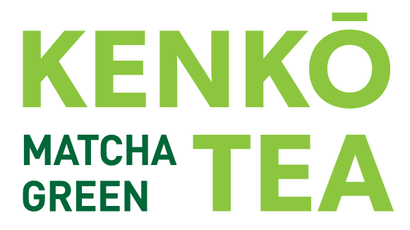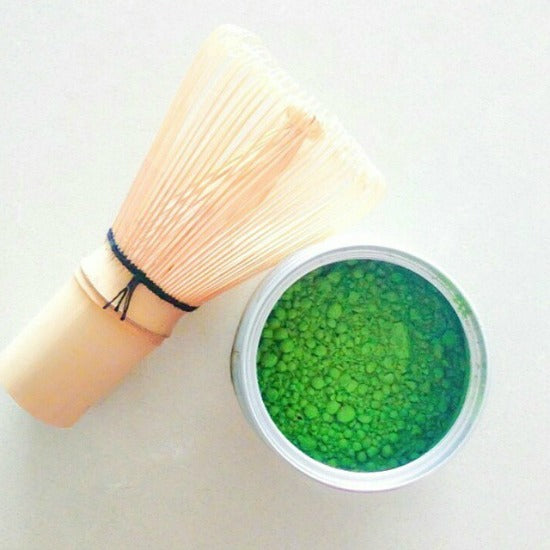
Photo by @awesomeeves
There’s a very common question we get here at Kenko Tea.
What’s the difference between a Ceremonial grade and Culinary/Cooking grade matcha?
In this article, we’d like to answer that popular question.
If you have purchased matcha before or been creative with it, you’ve probably encountered both types of matcha - and it’s important to know which one is best suited for your purpose.
Basically, there are 2 grades of matcha that are sold at Kenko Tea: Premium (Ceremonial) andCooking (Culinary) Grade. They each have distinct differences in both use and characteristics.


Premium Grade (L) by @rara_tang; Cooking Grade (R) by@thekindnessco
Matcha was originally only served as a ceremonial beverage during traditional tea ceremonies in Japan.
Nowadays, matcha is used for a wide variety of food and drink recipes. You can use matcha to make smoothies, milkshakes, latte, cakes, ice cream or even chocolate! Whether it’s baked, shaken, frozen or blended, matcha can be used to create brilliant flavors and outlandish recipes.
In addition to the simple split between ceremonial and culinary matcha, these new uses for matcha have also given rise to different grades of tea for both classes.
To fully understand all of the differences across the spectrum of matcha products, first we need to start at the very beginning, where green tea is turned into powder.
Matcha vs. Green Tea Powder
Many people have the misconception that matcha is simply regular green tea crushed into a fine powder.
However, matcha is unique to Japan, where a special cultivating method has been developed to give this tea extraordinary nutrient and flavor profiles. There are countries that have grown and produced green tea powder, but it is not matcha!
The most obvious distinction between matcha and green tea powder is the color. Matcha’s rich chlorophyll content gives it a vibrant bright green color, whereas green tea powder has a yellow-brown color.
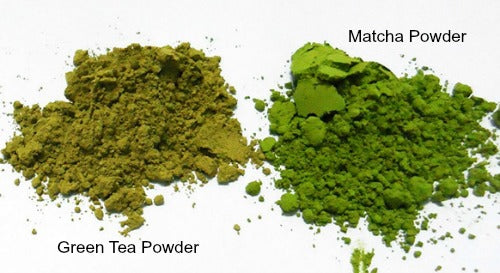
Color of Green Tea Powder vs. Matcha Powder
Matcha is ground to a powder using a traditional slow-turning wheel, which grinds about only 40g of matcha powder per hour. This slow motion process helps minimize friction and prevents the tea being ‘burned’ to retain its nutrients, chlorophyll and green color.
On the other hand, green tea powder is pulverized by air pressure, which can overcook it, which results in its yellow-brown hue.
Another distinct difference between matcha and green tea powder is the taste.
Matcha has a naturally sweet and smooth flavor with a hint of astringency, due to the amino acid theanine. Green tea powder tends to taste more flat and abrasive.
So the next time you are looking for matcha, make sure it’s from Japan, and that the color and taste are what they should be for this unique product.
Ceremonial vs. Culinary Grades

Traditional Matcha Green Tea by @urbanxkoi
Now we know what matcha is, let’s discuss the main differences between Ceremonial and Culinary grade.
When it comes to buying matcha, it’s important to know the difference. You want the best matcha product that fits perfectly with what you want to do with it. A matcha made for baking may not be the best choice for a tea ceremony, and vice versa.
Ceremonial grade is the highest matcha grade made from the youngest tea leaves. All stems and veins are removed from the leaves to obtain a very smooth and fine texture.
Culinary grade matcha is also made from young tea leaves, but these are comparatively older to those used for the ceremonial grade.
Because of that, ceremonial and culinary grade matcha have slightly different flavor profiles, making them more suitable for different tasks.
Let’s run through the differences:
Use
Ceremonial grade matcha is used for traditional occasions, such as Japanese tea ceremonies. Culinary grade matcha is used in cooking, baking and making everyday beverage blends.
For ceremonial grade matcha, it’s recommended to only mix it with hot water and nothing else. Ceremonial grade has a very delicate flavor so must be served as purely as possible.
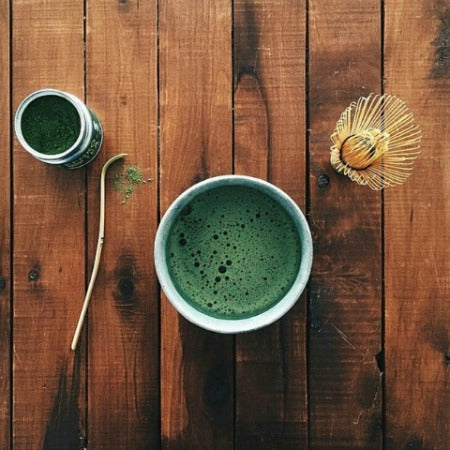
Ceremonial Matcha Grade in Tea Ceremony by @eugenekhooyr
In contrast, culinary grade matcha pairs up with anything. Whether it’s matcha ice cream, matcha cakes or matcha cookies, culinary grade matcha can be mixed and matched to your taste bud’s delight.
You can check out our collection of matcha recipes here!

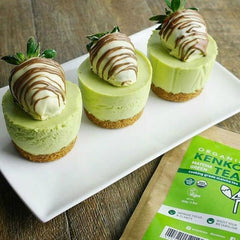
Matcha chocolate (L) by @vegan_naturalee; Matcha cheesecake (R) by @jollyeater
Flavour
As mentioned above, the flavor of ceremonial grade matcha is very delicate.
It is naturally sweet but can be easily masked by added flavors, which is why it is best served only with hot water. You can drink ceremonial grade matcha on its own, simply enjoying its subtle delights.
On the other hand, culinary grade matcha is harvested from slightly older leaves. Its flavor is more robust, bitter, and less sweet than the ceremonial grade. Because of that, you can use other additive flavors to cook, bake, shake, or mix with this matcha grade without it losing its distinctive taste.
Aroma
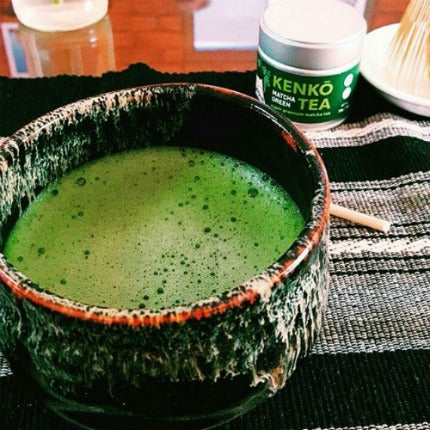
Matcha Tea with Kenko Matcha Premium Grade by @badkebad89
Both grades of matcha should smell very similar – that grassy, fresh aroma.
However, this aroma is simply an indication of the high quality of the matcha, not of the grade. No matter what grade you want, it should have a fresh smell.
Colour
Ceremonial grade matcha has a bright, vibrant green color because of the rich content of chlorophyll in the young leaves.
Culinary grade is less vibrant than ceremonial but still very green because it’s a high quality matcha product.
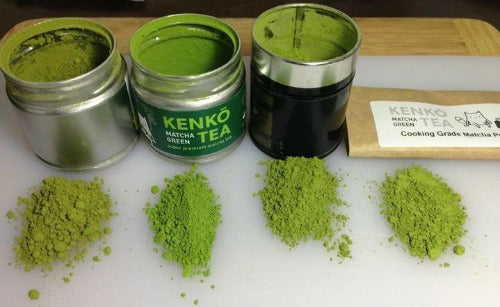
Kenko Premium (2nd) & Cooking (4th) Matcha Grade’s color vs. those of another brand
Texture
Both grades of matcha should feel fine and smooth to the touch, like eye shadow. They should not feel coarse or gritty, as that indicates a low quality matcha.
Price
The different prices you can pay for different matcha grades are due to the flavor profile.
Ceremonial, the highest grade, has the more delicate and milder flavor profile. Its production is more complicated so the natural flavor can he preserved. This means the price is higher than culinary. It is also produced exclusively in Japan.
Culinary is cheaper as its flavor profile is stronger and easier to retain throughout the production process. However, the price does not reflect its quality. It’s still high grade matcha, just not as high grade as ceremonial.
Quality
Following on from the last point, one the common misconceptions about matcha is that a lower grade means lower quality.
However, both matcha grades are high quality, and the only differences are price, flavor, and end use. As long as they present the vibrant green color, the fresh aroma and the fine smooth texture, both ceremonial and culinary matcha, are considered high quality products.
Koicha vs. Usucha Matcha
So, if you decide to cook with matcha, you can check out our collection of matcha recipes using culinary grade here!
If you want to try traditional matcha tea with ceremonial grade, then it’s time to learn about the differences between Koicha and Usucha matcha!
Koicha (thick) and Usucha (thin) are the two types of matcha tea made with ceremonial grade. Let’s see the differences between them:
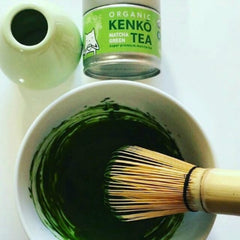
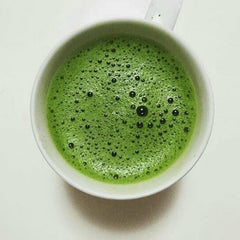
Koicha Tea (L) by @yummiegirl; Usucha Tea (R) by @begin_anywhere
Method
The preparation of Koicha and Usucha matcha tea is different, but very simple. Koicha is thick matcha mixed with very little water, whereas Usucha is mixed with more water.
For Koicha, roughly 2 tsp (4g) of matcha is mixed with 1 oz (30 ml) of water. With Koicha, you don’t have to whisk much as the idea is not to make froth. A slower kneading movement from left to right, up and down, finished with a gentle 360 degree rotation is enough to create a thick consistency.
For Usucha, about 1g matcha, which is 4 times less, is mixed with 3-4 oz (80-100 ml) of water. The matcha is whisked briskly in the W or M motion until froth foams up.
Viscosity
Due to the different amount of water and matcha used, the viscosity of these 2 types is different. Koicha is more viscous (left), like honey or melted chocolate. And Usucha is far less viscous (right), like espresso or maybe even macchiato.
Flavour
Koicha is concentrated so it’s mellower and sweeter. In contrast, Usucha matcha is less sweet. But it should not be so unpleasantly bitter, as it indicates that the tea is not prepared properly or the quality of matcha is bad.
Matcha is very diverse in the grades and types available, so it’s always handy to know the differences.
We hope you now understand more about matcha grades and types and when to use them best.
If you want to experiment with our Cooking Grade, try our Matcha Latte or Matcha Smoothie Recipes.
All this talk about matcha is putting me in the mood for a warm matcha latte with Kenko Cooking Grade. What’s your choice?

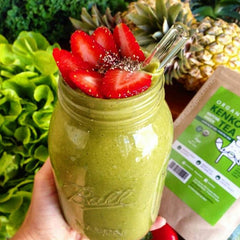
Matcha Latte (L) by @littlealleycafe; Matcha Smoothie (R) by @ninalovesummer
---------------------------------------------------------------------
Love this post? Then, please don't forget to
